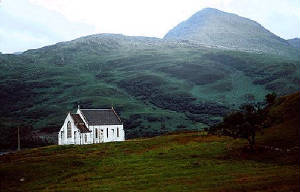|
Robert Louis Stevenson's Kidnapped |
|||
|
|||
|
Historical Background
|
|||
|
|
||
|
Robert Louis Stevenson's late victorian romantic adventure, Kidnapped, examines the 18th century
Scottish clan rivalries and its historical impact. Although Stevenson's primary audience was young people, Kidnapped's historical
authenticity has often appealed to adults. (Quiller-Couch 386) The history of the Jacobites dates back to the Glorious Revolution, which occurred in England in 1688. The
Catholic King James I was dethroned. James' supporters, or Jacobites, wanted to restore their heir, a Stewart clansman, on
the throne. Kidnapped takes place in 1751, several years after the Jacobite rebellions, which lasted from
about 1688 to 1746 (Clarke). Many of the characters in Kidnapped were in fact, real historical characters. In 1752 in Scotland's
West Highlands, Colin Campbell, a British government representative, was murdered by a sniper. The authorities believed the
assaasin to be Alan Breck Stewart, who fled the country and was never caught. James Stewart was charged with the crime and
hanged. Both Alan and James served in the Jacobite army, which during 1745 - 1746, tried to overthrow the British monarch,
George II (Hunter). The Campbell clan is loyal to the British government, therefore an enemy of the Stewart clan (Clarke).
This intense animosity drives much of the storyline of Kidnapped. Readers during Stevenson's time would have been very familiar with the Jacobite
rebellions (Clarke), but it seems that the driving theme of the story remains a boy's adventure.
|
||
|
|
